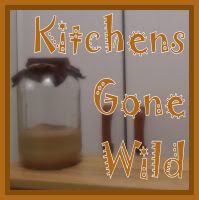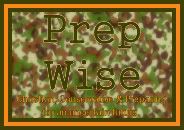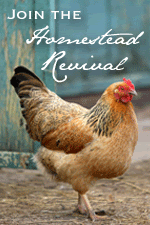 When making sourdough, I don't tend to dump half out anymore (as most recipes call for). I found, not only do I have more starter by the time it's ready, but that it also gets going quicker & makes for a healthier sourdough starter. It took EIGHT YEARS to perfect a starter. This starter has been going since June. I found the original recipe on Backwoods Home, but after even that flopped, I've tweaked it to fit my (at the time) limited experience with sourdough. Rye has definitely been the easiest for me to start. I had a rye & a regular flour sourdough side by side when I made this one, and the only way I could get the regular starter going, was by mixing my rye & using the same spoon (without rinsing) in the regular starter. After they were both started (thanks to the rye), I just dumped them together. Rye is my tried & true of choice.
When making sourdough, I don't tend to dump half out anymore (as most recipes call for). I found, not only do I have more starter by the time it's ready, but that it also gets going quicker & makes for a healthier sourdough starter. It took EIGHT YEARS to perfect a starter. This starter has been going since June. I found the original recipe on Backwoods Home, but after even that flopped, I've tweaked it to fit my (at the time) limited experience with sourdough. Rye has definitely been the easiest for me to start. I had a rye & a regular flour sourdough side by side when I made this one, and the only way I could get the regular starter going, was by mixing my rye & using the same spoon (without rinsing) in the regular starter. After they were both started (thanks to the rye), I just dumped them together. Rye is my tried & true of choice.Once you get your sourdough going, you have to dry some. If for any reason your sourdough starter dies, or you have to leave it unattended while you go out of town & forget to put it in the refrigerator, you'll want a back up. Drying is easy & probably best method of having a back up. If you do need to leave your starter unattended, you can store it in the refrigerator, where the chill will retard it's growth. I'll write more posts on storing & drying starters soon. Today you want to start your sourdough starter. You'll have a week & a half before you'll need the recipes & storage techniques.
I've added some links & information after the recipe to show why sourdough bread is a much healthier option than a yeast bread or an un-soaked bread.
In a large, clean, glass jar mix the following together with a plastic, wooden, bamboo or silicone stirrer (spoon, spatula, whisk). Never, ever use metal for any part of the sourdough starter making/caring process. It will react to the acids & kill the good germies.
Day 1
1/2 cup rye flour
1/2 cup water
Day 2
Stir
Day 3
Add & mix well:
1/4 cup rye flour
1/4 cup white flour
1/2 cup water
Add & mix well:
1/8 cup rye flour
3/8 cup white flour
1/2 cup water
Day 5
Add & mix well:
1/8 cup rye flour
3/8 cup white flour
1/2 cup water
By this time your starter should have a sour smell. This can range from a beer smell to a fruity smell. You'll see it live. It will bubble. It will be good :D
Day 6 is when you quit using rye & begin adding unbleached all-purpose flour. You'll use equal parts water & all-purpose flour until your starter is rising & falling regularly (1/4 cup each minimum). Mine took all of 2 or 3 days to see this. If your rye starter was a success & your home is relatively warm, you should have rise & fall within just a few days. Make sure that this continues for 2-3 days before claiming your starter just right. All in all, your starter should take about 10-14 days to "perfect." As you tend to your starter over the next few months, it will get better & better.
When you switch to the all purpose feeding, I highly recommend using just that. Your starter is still fragile, and you want the content of all purpose flour to make it thrive. After your starter has lived for several weeks (not from the start, but actually "come alive" you can switch to a wheat flour. I find WW pastry flour ROCKS!).
Why Sourdough? By soaking your flours, you break down the phytic acids in flours that hinder the absorption of minerals by the body. Here are some links for your perusal. Google will also bring up MANY hits if you type phytic acid, sourdough:
















7 comments:
I've been wanting to make a starter. Can I make it with whole wheat flour? I grind my own and would like to use all wheat if possible.
I know people that have started with wheat flour & water, but IME it hasn't worked. The biggest factors in starting a SD is the content of flour & the live yeasties in the air of your home. Some people use crushed organic grapes in a cheesecloth or muslin bag (the "packaging" makes for easy removal). The natural fruit yeast is supposed to be an excellent starter. Some people place their starters next to a bowl of ripe fruit. Some just have all the luck (LOL).
In any event, when you asked your question, did you mean a rye starter or JUST wheat & water? If you meant the latter, you can try half water, half flour & add daily the same amounts of each, stirring well.
Because I love your blog, you have been nominated for a Lemonade Stand Award!
Michaela-
looks great and easy without lots of flour in excess.
(I've seen some where you use a bunch of flour and pour off a bunch in the process- i knew there had to be a better way and looks like you've found it!)
I have trouble getting rye sometimes... well, the grain...
I need to work towards it a little harder- just for this! ;-)
I know this isn't about sour dough but I was wandering could you explain to me how you maker your deer sausage and maybe the recipe?
Thanks so much
Joy
ebcsmom@gmail.com
This is great. I tried making a rye starter a few years ago, but it ended up not working out for me. I can't remember if I ended up adding a bit of yeast or not... I'm going to give your method a try. Thanks!
Uh oh... I used a regular teaspoon on the second day... so does this mean I killed it?
I WILL perfect this, one way or another, so thanks for your tips - and keep 'em coming! lol!
Post a Comment